
The Leading Cause of Death in Virtual Meetings
Hint — it's not PowerPoint.
With roots dating back to the early twentieth century, innovations in audiovisual (AV) technology have unequivocally shaped modern society and the world as we know it. Transcending all aspects of life, the AV industry has provided humanity with an astonishing capacity for communication, equipping us with the latest tools, equipment, and technology to stay connected.
As we continue to navigate the ongoing novel coronavirus pandemic, the power of audiovisual technology has never been more important. COVID-19 sparked a fundamental shift in how and where we work; the AV industry has provided the advanced platforms and equipment needed to help us succeed.
Authored by Thom Mullins, an expert in audiovisual services at AEI, this engaging exposé highlights key insights from two AVIXA Audio Power Hour sessions held last summer and moderated by Thom. Additional information regarding Thom, including links to each session, is included at the end of this feature.

Modern conferencing space at Seattle Children's Research Institute's Building Cure.
After two years of remote learning and virtual meetings, many have become keenly aware of both the benefits and challenges associated with modern conferencing technology. We have all struggled (or witnessed as others have) with sharing content, remembering which conferencing platform we are using, and trying to change settings on the fly as we jump between varying applications — Microsoft Teams to Zoom, GoToMeeting to Cisco, or BigMarker to Webex.
We have learned to log in early, performing all the necessary software updates before scheduled meeting times. We have gradually become more comfortable with not only being on video but learning to look and speak directly at the camera — helping recreate that face-to-face interaction many of us long to return to.
Despite how far society has come, however, we all still struggle with audio issues. How many times have you heard one (or more) of the following comments during a call?
- "You're muted; can you please unmute your microphone?!" Everyone fumbles about looking for which device is muted. Is it the hardware? Or the software? Which piece of hardware? Which software app is not working? Is it me? Is it someone else?
- "Your speech is muffled; I can't understand you!"
- "Someone is breathing heavily; can you mute yourself?"
- "Your audio is really “echoey,” or, “I can't understand you; could you move closer to your microphone?"
- "Who has the jet engine running in the background?" (We're not fans of ‘the fan’ in laptops and PCs.)
- "Please mute your microphone when you're not talking."
- "Your voice sounds funny — mechanical and choppy. You don't sound like yourself."
- “Sorry, my dog keeps barking!” Or for the cat owners, “Sorry, my cat just knocked down the bookshelf.”
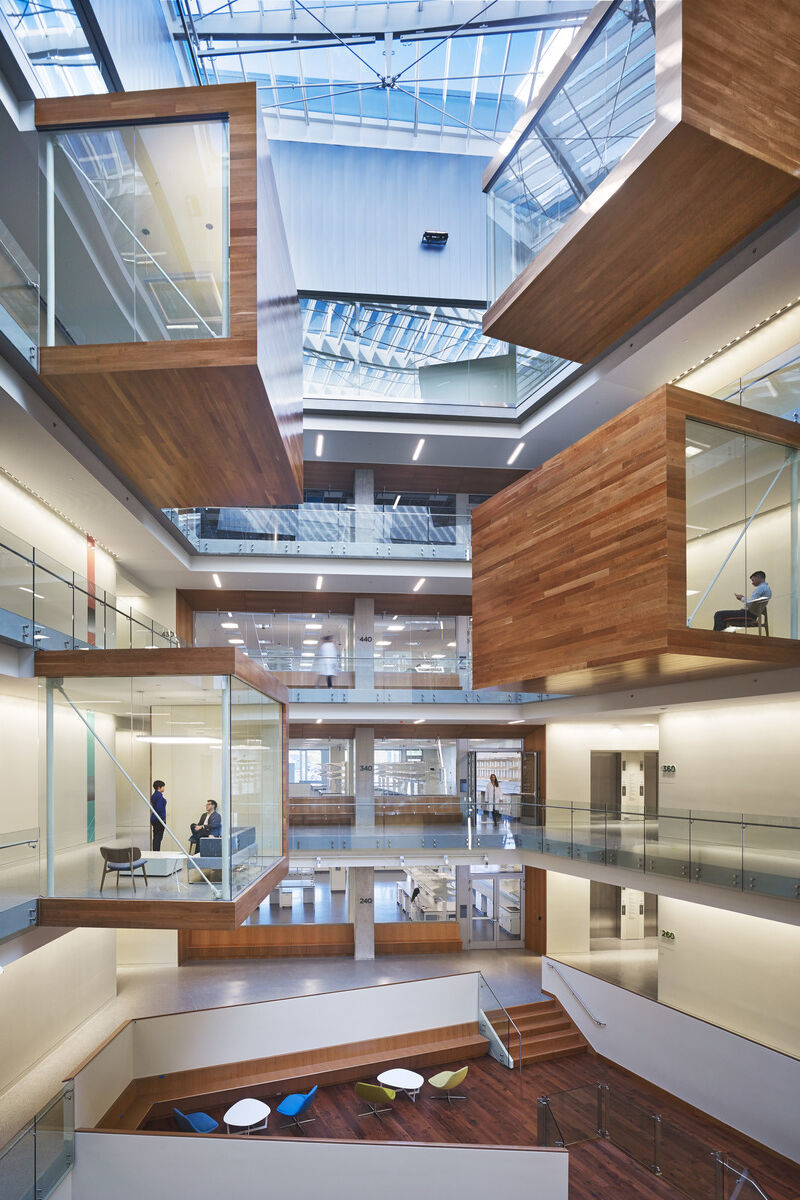
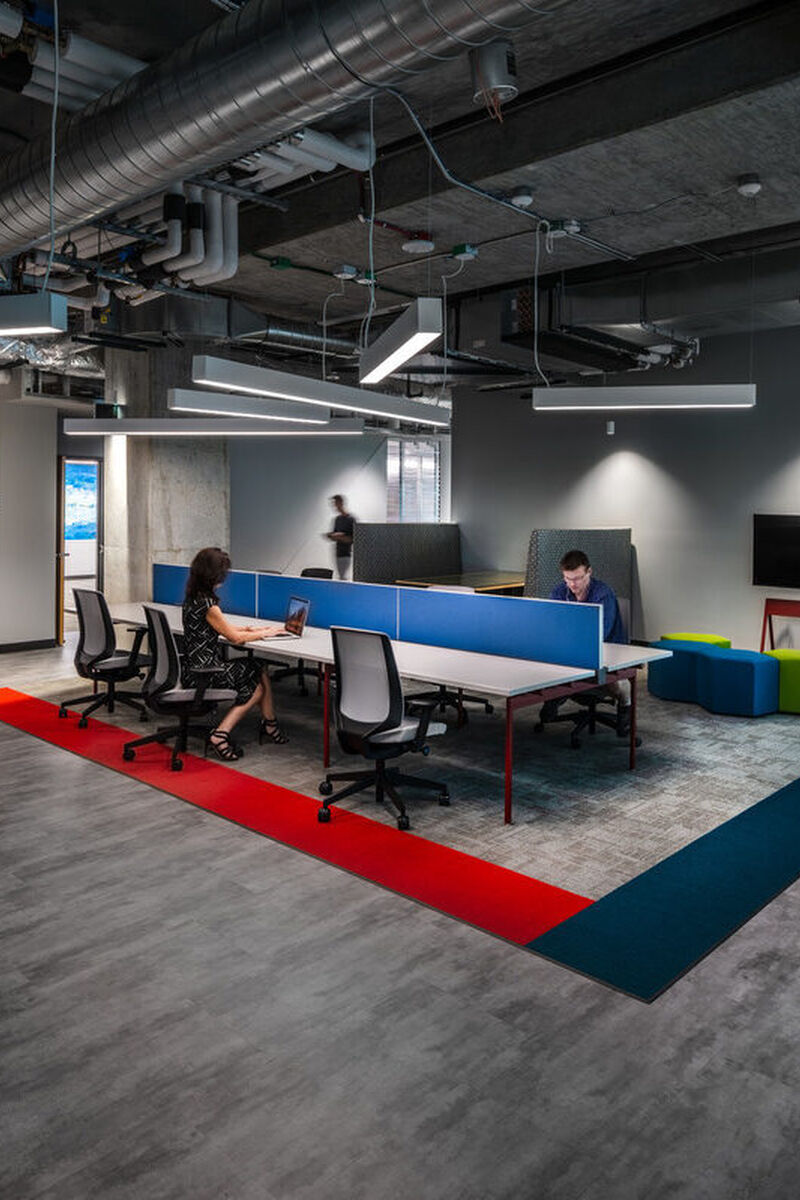
While many of these comments may seem more recent in nature, the truth is these challenges have always plagued the virtual world. We just have never relied on remote technology so heavily. Before COVID-19, four out of five frustrations associated with virtual meetings were related to audio — including issues with background noise, acoustical echoes, microphone performance, and differences in level between participants. So, has anything really changed?
No, not really.
When compared to video, providing a flawless audio experience is four times more important to participant satisfaction than anything else. Despite this, we often see the reverse in actual dollars spent. Instead of focusing corporate budgets on addressing audio and acoustics — the key factors in determining conferencing-related user experience and success — many organizations typically opt for investing in the latest video technologies instead. Several years ago, one of the foremost audio educators in the industry, Don Davis, observed:
If bad sound were fatal, audio would be the leading cause of death!
The actual leading cause of death in virtual meetings can be attributed to three key factors:
- Speech intelligibility
- Room design, treatment, and acoustics
- Microphone placement and integration

Modern lighting and absorptive panels — coupled with abundant natural daylighting and exterior views — optimize occupant experience in this UF Health conference space.
1 | Speech Intelligibility
Perhaps the most significant factor influencing conferencing audio quality is speech intelligibility.
In general, speech intelligibility refers to the “understandability” of speech and the ability to use speech for effective communication in everyday situations. For the individual, it can be affected by many factors, including pronunciation accuracy, audibility, speaking rate, and comfort with the language(s) being spoken.
Maximizing speech intelligibility is paramount to fostering high-quality audio in virtual meetings. To effectively minimize adverse “audibility” issues pertaining to speech intelligibility, one must consider background noise levels, room acoustics, and proper microphone placement. A problem with any one of those aspects is a detriment to virtual meeting success; combining two or more? Disastrous.
So, who are you going to call?

This large conferencing environment maximizes sound absorption through acoustic carpeting and absorptive wall paneling.
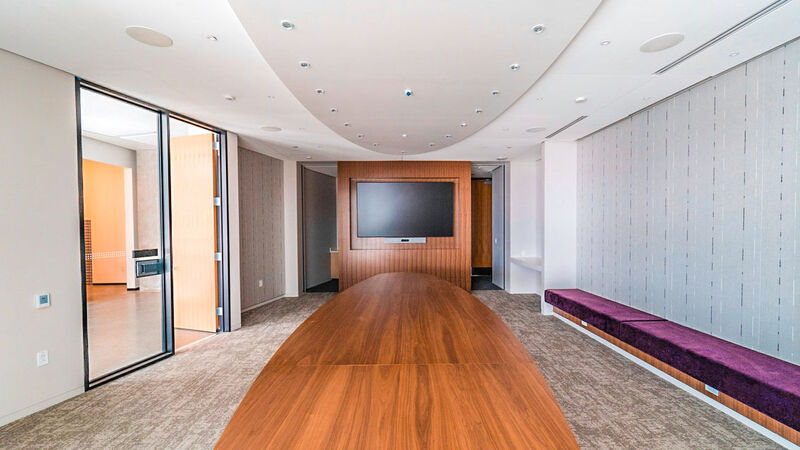
Floor-to-ceiling absorption (right) and canted walls help reduce echoes in this modern conference room.
2 | Room Design, Treatment, and Acoustics
Most audibility issues are related to the surrounding environment and can be addressed through proper room design, room treatment, and equipment usage.
While AEI does not specifically provide acoustical services as a design discipline, we work with project partners, including architects and owners, to help them optimize interior environments for maximum audibility — aka, getting it right. Some key issues we typically address with project architects and owners (to keep them from screaming into the void) include background noise, interior design elements, and acoustics.
Based on the room type and relevant adjacencies, AEI can recommend the appropriate STC rates for walls, doors, and windows — helping ensure acoustical privacy and effectiveness in reducing noise transmission as sound travels across varying spatial barriers.
Widely recognized as the standard metric for evaluating sound in building materials, STC ratings help designers improve speech and noise isolation between spaces.
Chart identifying common Sound Transmission Class (STC) ratings and associated levels of audibility.
Background Noise
Background noise remains the single largest impediment to achieving optimal room acoustics. The key challenge relates to isolation from background noise, which could come from an endless array of sources.
For conference rooms on the perimeter of a building, noise can come from automobile traffic or aircraft flying above, conversations in the hall, or toilets flushing. In those instances, it is important to ensure that the room boundaries —floors, ceilings, and walls — and penetrations of those boundaries (windows, doors, duct, or conduit penetrations) are well designed. Building floor to structural ceiling walls, minimizing glass, and providing suitable door seals are all important. If possible, strategically positioning conference rooms toward the middle of the floor plate in lower-traffic areas can help mitigate background noise. Refer to the adjacent chart for a list of common building materials and their associated acoustical considerations.
In addition to optimizing room boundaries and location, careful consideration should be given to the background noise associated with HVAC systems. Noise interference often arises from intake and exhaust vents within a designated space or even adjacent rooms sharing the same HVAC ductwork. Properly specifying duct and vent types, shapes, sizes, and sealing will all help alleviate background noise impacts. Architectural lighting elements should also be designed to mitigate fixture ballast noise levels.
| Material | STC Rating | What You Can Hear |
|---|---|---|
|
Single-pane glass window
|
26-30
|
Sentences spoken in a normal voice can be understood clearly
|
|
Double-pane window, hollow-core door, or typical interior wall with single layer of 5/8-inch drywall on each side (no insulation)
|
30-35
|
Sentences spoken in a normal tone of voice can still be heard with some straining
|
|
Solid-core wood door
|
35-40
|
Loud speech can be heard but not clearly understood
|
|
4-inch masonry block, grout filled
|
47
|
Loud speech is audibel only through strained hearing; music and heavy traffic can most likely still be heard
|
|
Double layer of 5/8-inch drywall on each side of wood-stud wall; flexible channels on one side and single batt insulation in between
|
57-60
|
Very loud speech is almost entirely inaudible; music can barely be heard; bass notes are disruptive
|
|
Double layer of 5/8-inch drywall on each side of double-wood/metal-stud walls (spaced a single foot apart); double batt insulation
|
62-65
|
Music is barely heard, and bass notes make a thumping noise; power equipment can be clearly heard
|
|
8-inch concrete block wall, painted, with 5/8-inch drywall on independent steel-stud walls; insulation in cavities
|
70
|
Music can be faintly heard if played very loud; power equipment barely audible
|
Isometric view of a 16-person conference room and recommended absorption placement.
Design and Treatment
Room design and treatment is the other half of this equation. Driven by an industry-wide emphasis on natural daylighting, corporate transparency, and increasing market competition, all-glass building and room façades have become a hallmark of modern architecture — a penchant also trending within the conference room context. The problem? Glass does not absorb sound.
Regardless of envelope type, building walls can be splayed so they are not parallel. This reduces the generation and propagation of flutter echoes that can hang in a room for extended periods of time — acoustical artifacts that significantly impact speech intelligibility. All it takes is a single wall; preferably a long one.
Acoustics
In addition to redirecting acoustical energy, building designers must ensure there is adequate absorption on the surfaces that matter the most. Usually, the floor and the ceiling are the two single largest surface areas of any given room. Carpeting on the floors not only absorbs sound but prevents scraping or squeaking that can occur when moving chairs or other furniture around.
Acoustical ceiling tiles further aid in absorption and, if chosen correctly, can provide additional isolation from flanking noise over the room’s perimeter walls. Additional strategies include applying caulk around the ceiling perimeter, as pictured to the right.
The last remaining surface areas are the walls. Absorptive panels can be added from roughly 36 to 84 inches above a finished floor. This four-foot-wide panel places absorption at the right height to absorb acoustic energy for people seated in the room talking to each other from across the table (see graphic below).
Close-up view of the perimeter of a conference room and common strategies for mitigating sound transmission across room boundaries.
Illustration highlighting use of absorptive panels and splayed side walls to mitigate sound transmission.
An additional option is to place absorption on the front wall around any display(s). Since most people participating in a video conference will naturally be facing the screen, this solution helps reduce acoustical energy immediately, leaving less to bounce around the room.
Given the complex relationship between audio quality and room design, this is often where we see project priorities begin to shift, leaving many wondering — can’t we just address all these issues with advanced microphones, loudspeakers, and electronics?
No, not really.
If a room is poorly designed and constructed, all the technology in the world will not alter the fundamental physics of sound pertaining to space. After determining the appropriate strategies for optimizing the interior environment, it is time to address one of the cardinal rules of audiovisual design — microphone placement.
3 | Microphone Placement and Integration
The next time you participate in a virtual meeting, pay attention to the level of ease or difficulty you experience when trying to hear and understand as other people are speaking. Then, make note of the type of microphone they are using and where that microphone is placed. It is likely you will find that the closer the microphone is to someone's mouth, the easier it is to understand them.
Pro Tip → Close miking
reduces the amount of room noise and increases the level of useful signal by moving the microphone as close to the mouth as possible. In a recent meeting I attended, people were using headsets with boom mics, both wired and wireless earbuds, built-in laptop microphones, conference phones, and mics located 6-12 inches away from their mouths. Which of these do you think was the easiest to hear and understand? If you guessed those with the microphone closest to their lips, you are correct! Each of the other choices was impaired by background noise and acoustical reflections in the room as a result of the microphone being positioned too far from the speaker's mouth and thus making it more difficult to have a quality conversation.
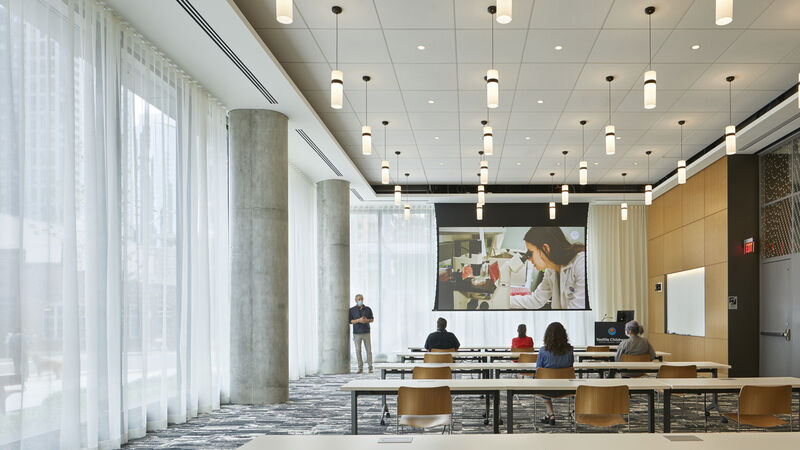
Regardless of conferencing space size, proper treatment and design will ensure optimal acoustics and user experience.

Highly transparent conference rooms are uniquely situated within the facility's primary entrance — maintaining acoustical control while simultaneously offering pleasing exterior views.
Purposeful Placement
Now, in a conference room where it is not possible to provide all participants with a headset, you will have to use microphones resting on the table (preferred) or in the ceiling (not preferred).
At the table, make sure the mic is no more than 18-24 inches from the person speaking and that you have one microphone for every two to three participants. There are digitally steerable microphone arrays that can be positioned either on the table — or in the ceiling — but they are typically more sophisticated and expensive than other solutions.
Though discouraged in general, if implementing ceiling-mounted microphones is necessary, it is imperative they are not placed adjacent to HVAC supply vents for two key reasons:
- Air will travel across the microphone, adding noise to the signal and thus decreasing audio quality.
- Microphones are subject to ceiling vibrations and will not only pick up vibrations but amplify them in the signal. To ensure optimal audio quality, ceiling-mounted microphones must be isolated from vibrations.
Pro Tip → Avoid placing ceiling microphones next to HVAC vents. Some owners implement “black-out zones” above conference room tables — aka, mics are only located in areas with no nearby lighting fixtures or HVAC vents.

Absorptive material is incorporated on the wall behind the flat-panel display.
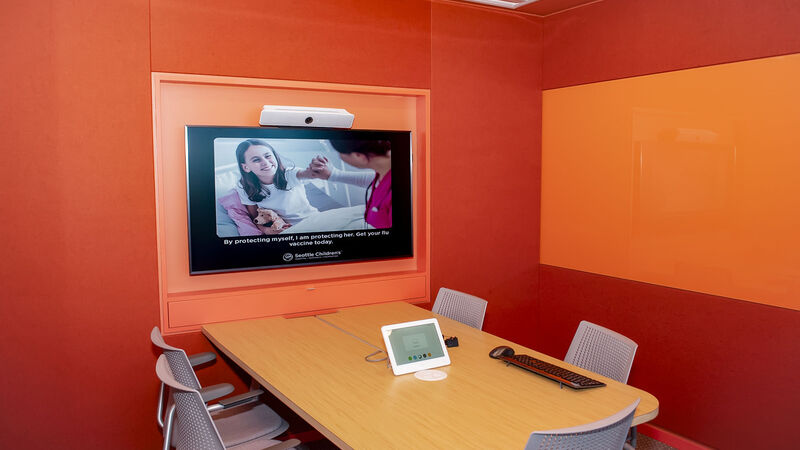
Modern technology and audiovisual equipment work in tandem with acoustical wall treatments to optimize sound and overall experience in this bold conference room.
Proper Integration
After placement, proper integration ensures microphones are connected to signal processing that provides additional noise reduction capabilities and acoustic echo cancellation — beyond what you have already been able to mitigate through proper room design and treatment.
Today, this is typically done either by the hardware and software (commonly referred to as the UC Engine) used to run the pertinent conferencing platform, such as Microsoft Teams, Zoom, and Cisco, or, if the room is too large, by a dedicated digital signal processor that provides these functions.
Pro Tip → Keep in mind that not all UC engines or conferencing apps are created equal and which app you choose will impact the AV system and the user interface uniquely. Choose your conferencing platform carefully, based on need and functional capabilities. And do not hesitate to recommend changes – that is how innovation occurs.

Becoming an Audio All-Star
So, what are the most crucial factors in creating an optimal user experience within conferencing environments?
- Set the tone → focus on superior speech intelligibility
- Lay the groundwork → optimize the room design
- Enhance the process → properly apply technology and equipment
Though simplified above, we understand that navigating the complexities of audiovisual design can be a challenge. We do not expect anyone to become an audio all-star overnight. But that’s where AEI comes in. We are here to collaborate with you on your next project, applying our deep knowledge and proven experience to design highly functional spaces and systems that deliver the best user experience.
We encourage you to watch and listen to AVIXA's latest webinars — moderated by Thom — available via the recordings below. Questions about your next AV project or any of the article contents? Reach out to Thom directly here.
“I remember sitting in on past design team calls where the architect’s microphone was positioned directly next to their computer’s exhaust fan. It sounded like a jet engine taking off. They switched to a Bluetooth headset with an integrated microphone and eliminated the problem.”



